Perak, the second-largest state in Malaysia, is best known for its capital city, Ipoh — a haven for food lovers seeking iconic dishes like silky smooth Hor Fun and succulent chicken rice. But beyond its culinary fame lies a treasure trove of attractions in Perak waiting to be explored. From stunning limestone caves and heritage towns to scenic eco-parks and relaxing hot springs, Perak offers a diverse range of experiences that cater to nature lovers, history buffs, and families alike.
Let’s dive into the top attractions in Perak you shouldn’t miss when you’re here!
Also read: A 5D4N Kuching Itinerary to Explore the Beauty of Borneo
Must-visit attractions in Perak
1. Kuala Kangsar heritage trail
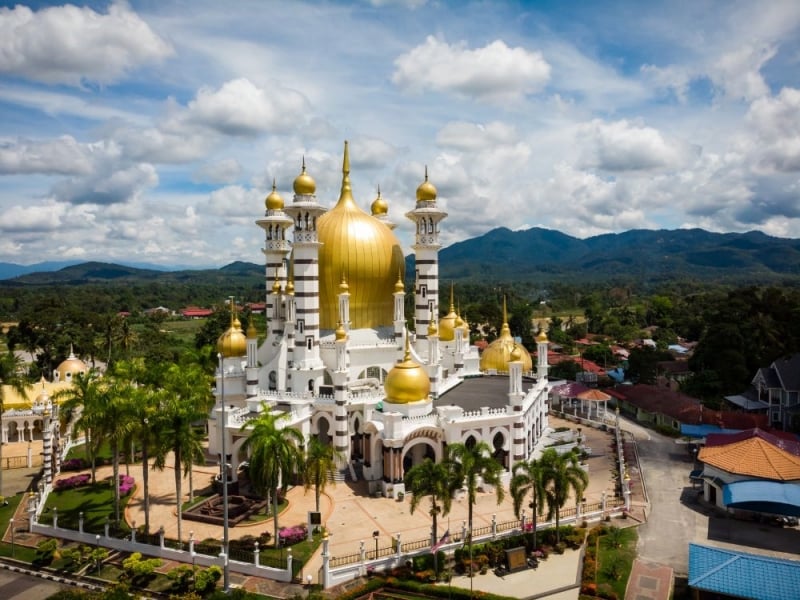
Image credit: Avid Photographer. Travel the world to capture moments and beautiful photos. Sony Alpha User from Getty Images
Kuala Kangsar, the esteemed royal town of Perak, situated a comfortable 48 kilometres north of Ipoh, presents a captivating glimpse into Malaysia’s regal past. Several striking buildings immediately command attention. The first of these is the magnificent Masjid Ubudiah, Perak’s royal mosque. An impressive architectural feat crowned with a constellation of gleaming golden domes, Masjid Ubudiah is widely regarded as one of Malaysia’s most beautiful mosques.

Interestingly, this iconic mosque was the design of Arthur Benison Hubback, a notable architect also responsible for the elegant Ipoh railway station and the historic Kuala Lumpur railway station. Sultan Idris Murshidul’adzam Shah, the 28th Sultan of Perak, generously funded its construction with RM 200,000 as an expression of gratitude for his recovery from a significant illness. The mosque’s construction concluded in late 1917, and today, visitors can still admire its grandeur.
Stepping inside, the crystal chandeliers and the intricate detailing adorning the ceilings, walls, doors, and carpets are immediately striking. For those wishing to explore the interior, it’s important to dress respectfully. The mosque thoughtfully provides a brown cloak for visitors to wear before entering. As is customary, there is a clear separation for men and women entering for prayers.
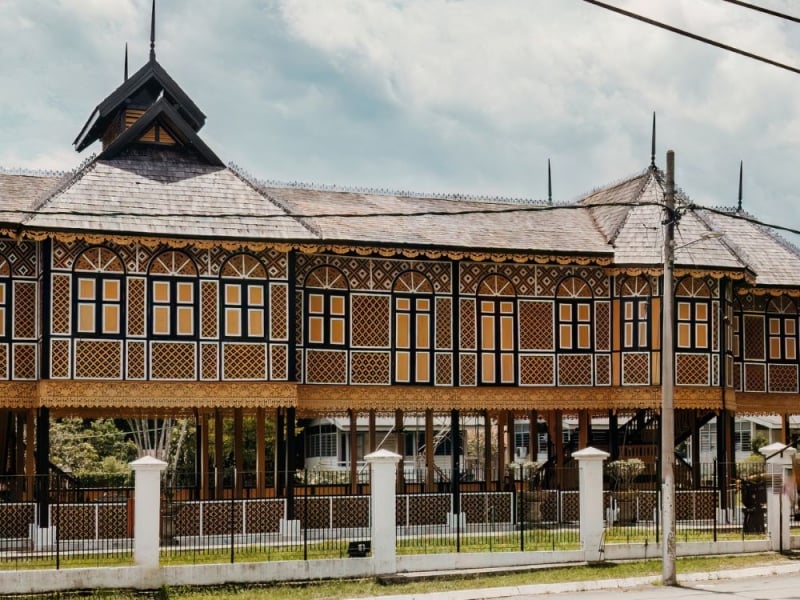
Image credit: ellinnur Bakarudin from ellinnur
Nearby stands Istana Kenangan, a former royal palace now serving as the Royal Museum of Perak. Constructed in 1926, Sultan Iskandar Shah resided here between 1931 and 1933 while awaiting the completion of Istana Iskandariah. Subsequently, Istana Kenangan played host to royal receptions and accommodated palace guests.

The building’s unique design, when viewed from above, is said to resemble a sword within its scabbard. This two-storey structure features bedchambers, family bedrooms, and a dining hall on the upper floor. The beauty and distinctiveness of this wooden edifice are further enhanced by exquisite wooden carvings and traditionally woven wall mats. It’s no doubt one of the top attractions in Perak worth visiting.
Masjid Ubudiah
Opening Hours: 10.00am – 5.00pm
Entrance Fee: Free
Address: Bukit Chandan, 33000 Kuala Kangsar, Perak, Malaysia
Telephone: +605-7761144
Istana Kenangan
Opening Hours: 9.30am-5pm Daily, Closed on Thursday 12.15pm-2.45pm, Fridays and Public Holidays
Entrance Fee: Free
Address: Istana Lama Bukit Chandan, Perak, 33000 Kuala Kangsar, Malaysia
Telephone: +605-7765500
2. Ipoh Railway Station
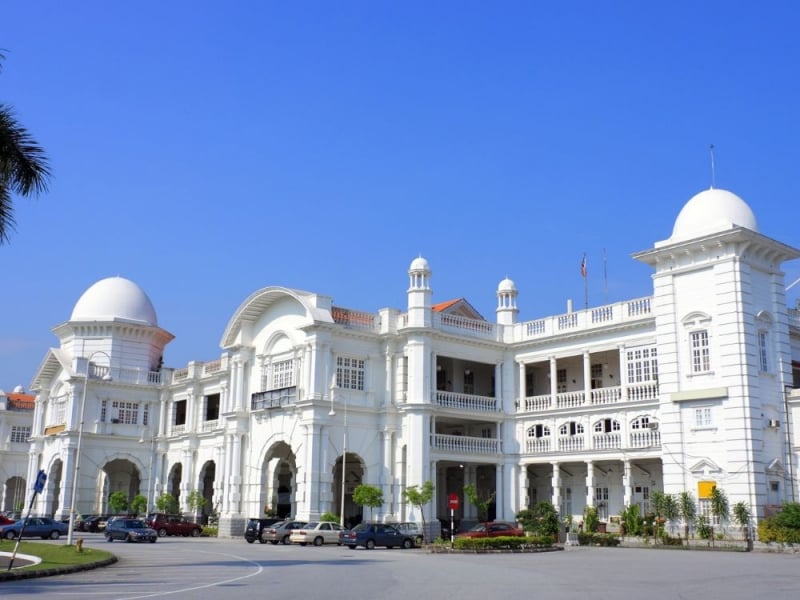
Image credit: mauhorng from Getty Images
The Ipoh Railway Station, affectionately nicknamed the “Taj Mahal of Ipoh,” was completed in 1935, replacing the original railway platform shelter. This striking white structure, built in a distinctive Neo-Moorish architectural style, is often cited as the second most beautiful railway station in Malaysia, after its counterpart in Kuala Lumpur.

Located on Jalan Panglima Bukit Gantang Wahab, the site for the station was initially intended for a hospital before its transformation into a vital transportation hub. Today, the station complex also houses the Majestic Hotel, adding to its historical significance. Interestingly, it even served as a filming location for the 1999 film “Anna and the King,” starring Jodie Foster and Chow Yun-Fatt, further cementing its place in popular culture.
Ipoh Railway Station
Entrance Fee: Free
Address: Ipoh Railway Station, Jalan Panglima Bukit Gantang Wahab, 30000 Ipoh, Perak, Malaysia
Telephone: +605 2540481
3. Tanjung Tualang Tin Dredge
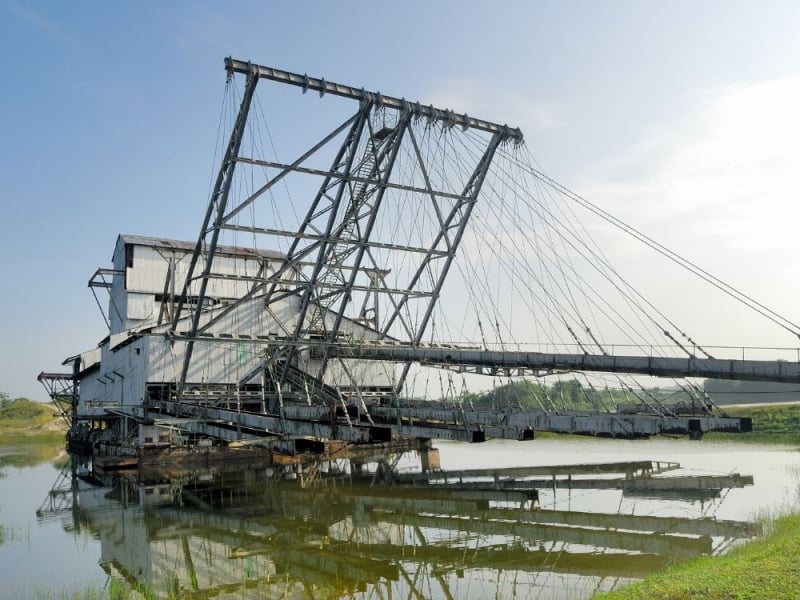
Image credit: RAVINDRAN JOHN SMITH from Getty Images
For those familiar with Malay, the name Perak translates to Silver, a fitting moniker considering the historical abundance of tin, which has a silvery appearance. This region was once renowned for its extensive tin-mining operations, and the decline in tin prices significantly impacted the state’s economy.

Today, the Tanjung Tualang Tin Dredge stands as the last remaining dredge, preserved by the local community and government as a valuable site for both education and tourism.

Imagine a floating factory within a mining pool – that’s essentially what a tin dredge is. These impressive machines operated by scooping up vast quantities of tin-bearing soil at the front. This soil then passed through a sophisticated system of oscillating drums, jigs, and screens designed to extract the precious tin. The residual waste materials were then expelled at the rear via a series of chutes.

Visitors can embark on a fascinating tour, often guided across the upper levels of this “iron ship.” At this attraction in Perak, you can witness the sheer scale of the buckets used to excavate the earth, offering a tangible understanding of the industrial processes involved. The views from the top deck across the surrounding landscape, dotted with former mining pools now often repurposed as prawn farms, fishing ponds, vibrant wetlands, or even scenic water features for housing developments, are particularly rewarding.

Keep an eye out for some of the surprisingly large tools used in its operation – you might even spot a wrench that looks like it belongs in a giant’s toolbox! The tour guides are on hand to share intriguing details about the dredge’s operation and the number of people required to run this remarkable piece of machinery.
Tanjung Tualang Tin Dredge
Opening Hours: Daily 8.30am to 6.00pm
Entrance Fee: RM6 for adults, RM3 for kids (Packages available)
Address: Tanjung Tualang Tin Dredge Ship, Warisan Kapal Korek (Tin Dredge Heritage), 9th Km, Jalan Tanjung Tualang, 31000, Batu Gajah, Perak.
Telephone: +605-3702253
4. Archaeological Heritage of the Lenggong Valley

For those with an interest in prehistory, the Lenggong Valley offers a remarkable journey into Malaysia’s distant past. The Lenggong Archaeological Museum serves as the central repository for numerous artefacts unearthed from this significant valley, most notably housing the celebrated “Perak Man.” This remarkably well-preserved human skeleton, dating back approximately 11,000 years, was discovered in 1991 at Gua Gunung Runtuh, a cave nestled within Elephant’s Head Hill (Bukit Kepala Gajah). The skeleton is believed to be that of a male in his fifties, standing around 157 cm tall.

Beyond the incredible discovery of Perak Man, the Lenggong Valley has yielded evidence of even earlier human habitation. Stone tools estimated to be around 100,000 years old have been excavated at sites such as Kampung Geluk and Kampung Temelong, underscoring the valley’s profound archaeological importance as the oldest known area of human activity in Peninsular Malaysia. This exceptional historical significance was formally recognised on 30th June 2012, when UNESCO inscribed the Lenggong Valley as a prestigious World Heritage site, ensuring its preservation for future generations to appreciate.
Kota Tampan Archaeological Museum
Opening Hours: Mon to Sat: 9AM – 5PM; Fri: 9AM – 12PM, 3PM – 5PM
Entrance Fee: Free.
Address: Department of National Heritage, Kota Tampan, Lenggong, 33400 Perak, Malaysia
Telephone: +605 7679700
5. Gopeng Heritage House Museum

Tucked away amongst a row of unassuming shophouses, the Gopeng Heritage House Museum might easily be mistaken for a quaint antique shop from the street. However, stepping inside is akin to travelling back a hundred years.

This unique museum is the passion project of Mr. Wong Kuan Cheong, who generously donated his family home for this purpose, with the local community actively involved in its creation. Remarkably, there is no admission fee, with the museum’s upkeep sustained through the kindness of community contributions and public donations.

Wandering through the museum, visitors are treated to a fascinating array of countless antiques, vintage furniture, and traditional calligraphy paintings, offering a tangible insight into the simpler lives of the Gopeng people of yesteryear. The upper level of the shophouse is particularly evocative, adorned with exquisite decorations and furnishings that vividly depict the lifestyle of a middle-class family a century ago.

The nostalgic rooms and their contents might feel familiar to those who enjoy period dramas, creating a sense of separation from the contemporary world just beyond its walls.

Besides that, the community also set up the Gopeng Museum to educate people on the history of tin mining. It was set up by a banker, Mr. Bernard Yaw, who wanted to fulfil his mother’s wish to rebrand the town of Gopeng and to open a Gopeng Museum.

You will find the equipment that the Chinese tin miners used, as well as other items used in their daily lives, back in those days.

This is one place where you can’t help but keep snapping photos, hoping to capture the nostalgic atmosphere and memories. However, nothing beats exploring the houses yourself.

Gopeng Museum
Opening Hours: 9:00am – 5:00pm (Only open from Friday to Tuesday)
Entrance Fee: Free
Address: No. 28, Eu Kong Street,31600 Gopeng, Perak
Tell: +605-359 782
Gopeng Heritage House
Opening Hours: 9.00am-3.00pm (Only On Weekends)
Entrance Fee: FREE
Address: 6, Jalan Sungai Itik, 31600 Gopeng, Perak.
Tel: 016-542 1287 (Phang Sek Hong)
6. Kinta Tin Mining (Gravel Pump) Museum

If you’re thinking, “Another tin mining museum?”, rest assured, the Kinta Tin Mining (Gravel Pump) Museum offers a truly distinct and engaging experience. While it might initially appear to be a conventional museum, a visit quickly reveals it to be Malaysia’s premier institution dedicated to the significant tin mining heritage of Kampar, a town historically renowned for its tin production.

Officially opened in October 2012, the museum specifically focuses on the gravel pump method of tin extraction. This remarkable space was established by Mr. Tan Sri Hew See Tong, a former tin miner, who transformed his own mining site into a multifaceted area encompassing the museum itself, commercial and industrial spaces, and an educational centre, all while diligently preserving Kampar’s valuable heritage.

Upon entering the museum grounds, visitors are immediately captivated by the impressive outdoor exhibits. Life-size figurines vividly depict the arduous tasks of tin miners utilising the gravel pump method in the now-dormant mines. Numerous pieces of heavy equipment, some bearing the marks of time, are displayed around the main hall’s exterior, offering a tangible connection to the industry’s past.

A notable feature near the entrance is an elephant statue, often referred to as the ‘founder’ of the rich tin deposits in the Kinta Valley. In fact, the Larut district was named after this very elephant! Legend has it that when ‘Larut’ went missing for three days and was eventually found, its leg was covered in mud containing… tin ore!

Inside the museum, thoughtfully crafted dioramas illustrate the labour and daily tasks of the local villagers involved in the search for minerals. Furthermore, a dedicated hallway showcases a compelling collection of photographic exhibits depicting mine sites and machinery. If you pause amidst your exploration, you might even hear subtle soundscapes of mining crews’ calls, construction sounds, and machinery noises in the background, adding an immersive layer to the experience.

Kinta Tin Ming (Gravel Pump) Museum
Opening Hours: Mon to Fri: 9AM – 1PM; Weekends and Public Holiday: 9AM – 4PM
Entrance Fee: Free
Address: Taman Bandar Baru, 31900 Kampar, Perak
Telephone: +605 4662632
7. Kellie’s Castle
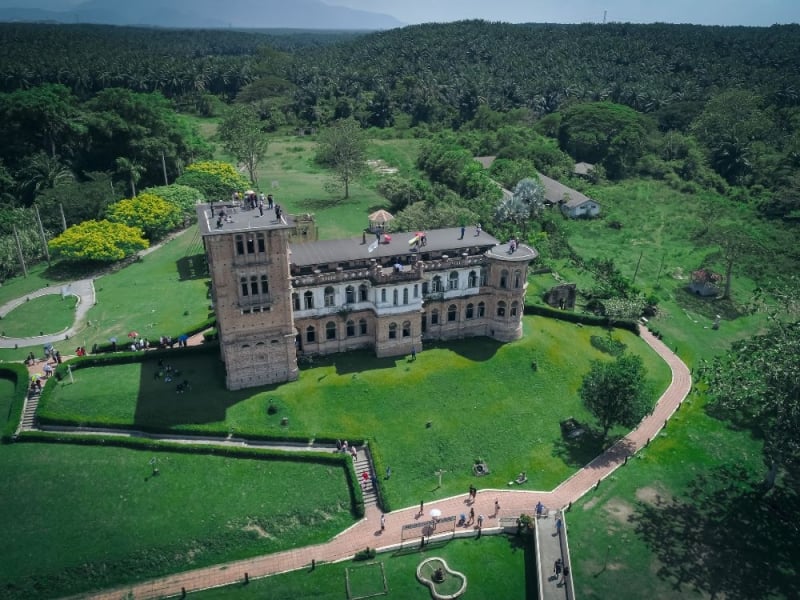
Image credit: Jalaluddin Abdul hilmi from Getty Images
Despite the persistent local legends of it being haunted, Kellie’s Castle remains a strikingly beautiful location, so much so that it’s a popular choice for wedding photoshoots. The castle’s origins are rooted in romance; it was envisioned and begun in 1915 by the Scottish planter William Kellie Smith as a testament of his love for his wife. However, its construction was never fully realised, leaving it steeped in an air of mystery and intertwined with poignant tales of love and untimely loss.
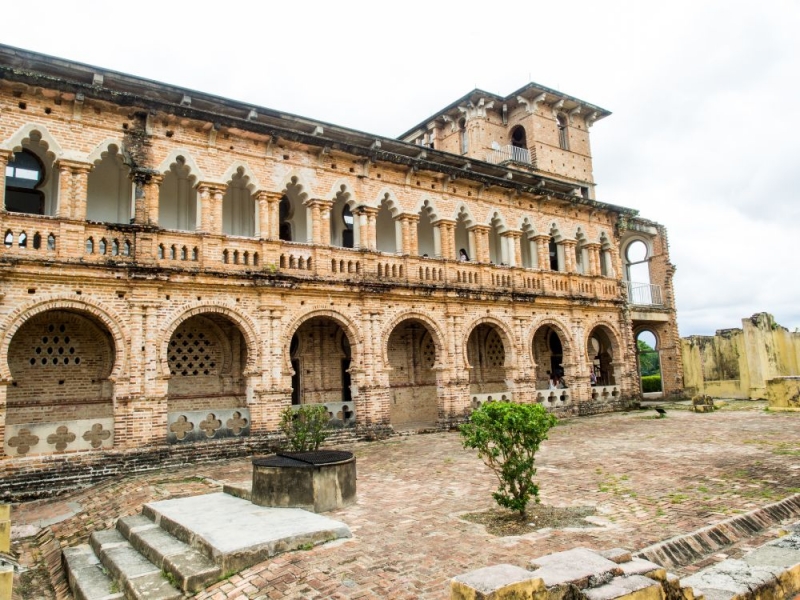
Image credit: jumruji from Getty Images
Perched atop a hill in Batu Gajah, amidst what was once a sprawling rubber estate, this Perak attraction commands a unique presence. Interestingly, Kellie Smith also commissioned the construction of a temple dedicated to the deity Mariamman, situated approximately 1.5 kilometres from the castle. This was undertaken when many of his workers tragically succumbed to the Spanish Flu. Adding to its architectural intrigue, Kellie’s Castle is believed to house the remnants of what would have been Malaysia’s first elevator, designed to travel from the rooftop down to the network of underground tunnels.
Sadly, the castle’s completion was thwarted by the untimely death of William Kellie Smith, who contracted pneumonia during a return trip to England and passed away at the age of 56.

Kellie’s wife sold the castle to a British company called Harrisons and Crossfield and left Malaysia with her children. Kellie’s Castle has since been refurbished. It was even used as a setting in the 1999 film “Anna and the King”.
Today, the remnants of the initial dwelling on the site are largely limited to a covered walkway, an open courtyard, and a section of a crumbling wall. Nevertheless, Kellie’s Castle stands as a prominent tourist attraction, drawing visitors with its captivating history, architectural uniqueness, and the lingering romantic and tragic stories that surround it.
Opening Hours: Daily 9.00am to 6.00pm
Entrance Fee: FREE (Age six and below) | RM2 (Primary School) | RM3 (Secondary School | RM4 (Adult) | RM5 (Non-Malaysian) Address: Chalet Mdkb Kellie’s Castle, Jalan Gopeng, Batu Gajah, 31000, Batu Gajah, Perak
Telephone: +605-3651336
There you have it, a list of attractions in Perak to visit during your next trip! Remember to check opening hours and any potential booking requirements before your visit to ensure that your trip is smooth and enjoyable.
Contributed by Tiffany’s Blog.




